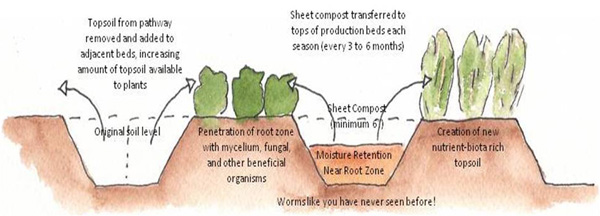
“A major issue in sustaining vegetable production is maintaining high soil quality in the face of common practices that work against it. Vegetable growing often involves intensive tillage, cultivation, exposure of almost-bare soil to the sun and rain for long periods, and heavy traffic from people and equipment. All of these practices tend to destroy soil organic matter and soil structure while increasing soil compaction.
This reduces yield over the long run because it creates a poor environment for root growth and function; also the soil biological community is adversely affected. Soils with poor quality cannot retain sufficient nutrients and moisture. Fruit trees also grow better when organic matter in the soil is increased, both from mulch as well as compost mixed into the soil.
A great solution to the soil building problem is utilizing the vast amount of wood chips available in urban areas from tree trimming companies. Wood chip trench-composting conserves water, controls weeds and builds long-term soil fertility. When it comes to building soil, nature relies heavily on trees — fallen limbs, leaves, cones, seeds and, eventually, the massive trunks. Adapting this natural process to urban agriculture by using free wood mulch from local tree trimming companies as soil-building material is a cost-effective and efficient strategy that promises huge, long-term returns.
When properly managed, an army of fungi, molds, and microorganisms feed on chipped wood mulches and dramatically increase levels of organic matter and beneficial biota in soil, vastly improving fertility, tilth, and productivity. This is beneficial on urban sites that require high — sustainable — returns due to land values and other inputs and costs that are generally much higher for urban agriculture operations. This method also addresses issues on some sites that have residual elements in the soil that may be toxic. Finally, this system generates large quantities of new topsoil – unlike many systems that just add enough fertility to feed the plants.”
Read the entire article for free at the source: Full Circle Sunny Vale
Image credit: Wolfram Alderson
Full Circle Sunny Vale home page
A friend of mine is planning to use this system on a moringa food forest. Commercially viable plants will be arranged in synergistic guilds.

Actually, an inverted system (compared to the blog post above) works extremely well in arid climates.
Brad Lancaster, who you have previously posted about,
https://naturalbuildingblog.siterubix.com/rainwater-harvesting/
… advocates using similar trenches and dished out soil beds to hold large organic “sponges” filling the trenches completely, or even overfilling to mound up the organic matter, which will hold water for very extended periods of time, if well mulched on top. Simply plant your vegetation directly in the organic filled trenches and use the mounded up ridges of soil as your pathways to avoid compaction of the growing spaces.
This video, different from the one previously posted on this blog, gives a demonstration of Lancaster’s techniques.
http://www.youtube.com/watch?v=xNnFknvSaMc
Lancaster’s system has proven itself many times over in the desert areas of the southwest U.S. The key is to have the trenches dug in such a way that they will have an area to overflow to if you get a massive burst of rain that fill them up.
The more rain your climate gets, the more important it becomes to have overflow capacity for your trenches.
I suspect that if one lives in or near a rainforest climate, then inverting Lancaster’s process like this blog post shows may be appropriate to provide enough drainage, but still put the runoff water to good use. Then again, I have absolutely zero experience in the very wet climates so my guess on that may be completely wrong. Perhaps someone with experience growing things in wet climates might confirm or shoot my hypothesis full of holes. As long as they have such experience, I welcome either response.
On a slightly different topic, perhaps worthy of a blog post if deemed appropriate by the blog authors…
For what it’s worth, the water level that Lancaster advocates in the video I listed above is a very useful tool in building construction. Valuable when digging foundation trenches, and assuring proper grading to get the correct slope for runoff. Well worth the effort to build one, right from the start of a construction project. It becomes easy to find the high and low spots before excavation, during excavation, and after.
Water is the enemy of all buildings, regardless of what they are made from. Controlling how and to where a structure sheds water is perhaps the most important factor for a builder. If it’s not the most important, it’s near the top anyway.
Here is Brad demonstrating how to build one. One can be built almost entirely from scrap components.
http://www.youtube.com/watch?v=pRjNA0DZZb4
Thanks for reminding me. Yes, that’s what Brad recommends in arid climates and I think he knows as much about this as anybody.
I’m in a rainy climate so that’s where I’m coming from.
I like it! It is both inexpensive and practical. I sent this blog to one of my students in Haiti who recently completed the Entrepreneur Training. He holds a degree in agronomy and is dedicated to making improvments in Haitian life.
As you know, the soil in Haiti is mostly very low quality, sometimes just rocks. They denuded the mountains and so most of the topsoil washed away. Can they get wood chips? Or maybe they can find another organic material (coconut husks? rice hulls?) in the trenches. But for sure they need to build up their soil and become food self sufficient.
This seems like one of the fastest, easiest ways to build good topsoil. Rotted wood chips improve soil structure. All 100% natural — no chemical fertilizer needed. The only downsides are you need loads of wood chips and the wood chips need to stay moist. So this may not work in arid areas.
Top 10 Best Permaculture Websites: http://www.topsite.com/best/permaculture